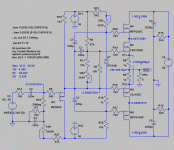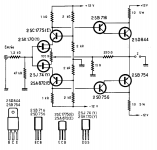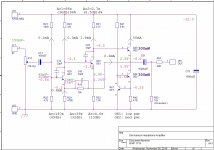My design in progress.... I would love to see power amps that act only as a current gain stages with different currents of course (i.e. high current buffers)...
Attachments
My design in progress
Hi ! i am not an expert but yes something like this. 🙂😉
A buffer should have from little to no effect on the sound with the VAS setting the sound. 🙄
In the example i have attached i see something looking like a diamond buffer at the output. The diamond buffer is a very elegant schematic with no feedback
Usually is for line stage applications ... nevertheless i guess it can be built with much more powerful parts.
Can it be conceptually the best possible buffer ? 🙄
I would be extremely interested in knowing this ... how good of a design is a diamond buffer
Last edited:
We are DIY, we only do bests. 🙂
Best fidelity, best imaging, best measurement, best in simplicity, best efficiency, best price and other bests, take your pick. There is no need to consider the second best.
Best fidelity, best imaging, best measurement, best in simplicity, best efficiency, best price and other bests, take your pick. There is no need to consider the second best.
A buffer is not a voltage amplifier, it's a current amplifier.
For the benefit of well sounding buffer amplifiers, the voltage amplification has to be realised by another stage or circuit.
Does the buffer sound nice? Maybe it's the voltage amplifier in front of doing the nice things. The diamond is symmetrical; I do not know people who can distinguish buffer amplifiers sonically from each other. Most say they can as long as they know another 'thing' is used. Double blind tests leaves all guru's in the dark.
The Hiraga posted by you is the 'larger' amp, 15W or so. The other is just 8W.
For the benefit of well sounding buffer amplifiers, the voltage amplification has to be realised by another stage or circuit.
Does the buffer sound nice? Maybe it's the voltage amplifier in front of doing the nice things. The diamond is symmetrical; I do not know people who can distinguish buffer amplifiers sonically from each other. Most say they can as long as they know another 'thing' is used. Double blind tests leaves all guru's in the dark.
The Hiraga posted by you is the 'larger' amp, 15W or so. The other is just 8W.
Attachments
...The diamond buffer is a very elegant schematic with no feedback ....
It has 100% feedback in every stage.
Right so! It has 100% local feedback.It has 100% feedback in every stage.
This kind of feedback is mostly harmless, it's another thing when overal feedback over three stages has to correct all diverging effects, not to mention phase shifts in the hf-bands.
Designing are at least three things at the same time. Make a dc-stable design, make an ac flat design, balance the act of feedback (overall vs local) and have it a precise or pleasent sound. That's four balls in the air.
In another topic (Germanium audio preamplifier) a challenge was to adopt an existing design to germanium bjt's. Because only pnp's were allowed, I contemplated another approach from scratch.
Not to intent crossposting, but as an example what's involved in the designproces.
One can observe dc-settings, ac-values and peak-figures. Also, losts of estimations are still open for adjustments (millercaps) or reconfigurations.
Being it the first shot, I'm not happy with the balance of inputsensivety, amplifications and powersupply-dissipation-output.
That will take some iterations ('redesigns') to get it closer to the target.
Not to intent crossposting, but as an example what's involved in the designproces.
One can observe dc-settings, ac-values and peak-figures. Also, losts of estimations are still open for adjustments (millercaps) or reconfigurations.
Being it the first shot, I'm not happy with the balance of inputsensivety, amplifications and powersupply-dissipation-output.
That will take some iterations ('redesigns') to get it closer to the target.
Attachments
It has 100% feedback in every stage
Hi i was clearly wrong as usual ... i think i misunderstood what i read
Maybe the man was referring to loop feedback or something ... 😱
Right so! It has 100% local feedback.
This kind of feedback is mostly harmless,
it's another thing when overal feedback over three stages has to correct all diverging effects, not to mention phase shifts in the hf-bands.
Designing are at least three things at the same time.
Make a dc-stable design, make an ac flat design, balance the act of feedback (overall vs local) and have it a precise or pleasent sound.
That's four balls in the air
Hi very very interesting and this explain the difficulty in designing a good sounding unit.
There is a concept ... time constant ... i do not understand what it is but rings me a bell. Said differently ... what makes local feedback generally less harmful to the sound than global/overall/loop feedback ? 🙄
If this is true of course ? 😱
Last edited:
Thanks ! at a first look seems very very technical but i will try to get the most i can
Regards, gino
...what makes local feedback generally less harmful to the sound than global/overall/loop feedback...
Not to go into technical details, but there mainly three ways of adjusting ('feedback') to correct a diverging result from a intented original which has to be processed in a certain way ('amplification').
The slowest and for most people the naturally way is to correct after things have diverged. The deviation has to be distilled from the result and the opposite of that added again to equal the output-with-proces with the input-without-proces.
This can be done at the input (general used feedback) or at the output (current dumping techniques).
This is called Backwards Euler (a mathematician of the former century).
A better way is to 'predict' the 'erroneous character' of the proces and add a correcting mechanism within the proces itself. An emitterresistor attached to the emitter of a transistor is such a technique. It 'flattens the logarithmic' nature of the transistor suppressing nasty sounding uneven harmonics generated by this logarithmic process (see the right side of my signature below).
This is called Forwards Euler (the same mathematician).
The swiftest way is the process that correct itself. Consider a self-stabilising balance or bascule. It will not go off balance by an internal intrinsic stability.
There is not a good example in electronics at hand.
This is called Moving Avarage (no mathematician involved).
Curiously enough, in electronics and audio more specific, the first group is analythical, precise and is claimed to sound harsh. Lots of electronic components are used here. The second group is more 'rounded' yet more detailed and is claimed to sound pleasant. Less components is more is the motto here. The third group is best understood as the actual live performace of art and maybe life itself. No artificial things, opinions or belief, just the experience.
In short, when overall feedback applied in a decent way, it's ok. But be sure to incorporate sufficient local feedback to maintain the fluidity of the proces.
Hence all these values in my design in post 107. Local feedback with emitterresistors and millercapacitors and an overall feedback for ac response and dc stability.
Last edited:
That's the process of designing audio circuits for you 🙂Thanks ! at a first look seems very very technical but i will try to get the most i can
Regards, gino
Many thanks scottjoplin!!!
This is a must read for all diy's.
Even those less familiar with math will pick up the message between the formulae.
Big hurrey for Bruno!
Now I know (again) why I have to iterate several times a first shot from scratch.
Balance of amplification per stage (less on primer TCA, more on the VAS... sorry TIA) and raising openloopgain by cap-bypassing the local feedback resistor of the TIA to appropiate levels.
Will a double two-stage general feedback trick (double handclap feedback) do better? In this humble setup not: to little overall loopgain per combo.
Anyway, the process of audio design. Quite a question, ample discussion, various opinions, answers pointing towards.
....There is a concept ... time constant ... i do not understand what it is but rings me a bell....
Fill a bucket with water. Punch a hole in the bottom. How fast does it drain?
(It varies from full to empty. In electronics-math it is convenient to take the point it is 63% drained.)
Make a bigger hole, it drains faster. A bigger bucket with the same hole, slower.
Similar thoughts if you fill and drain through a hose. Fat hose goes faster than a skinny hose.
Here's a different analogy. Balance on a playground teeter-totter. It will go-over in about a second. Hold a stick balanced on your hand. It will fall over in maybe 1/10th second. "Balancing" is a feedback loop around your eye/balance and the power in your legs. Now balance on the teeter-totter while balancing a stick on your hand. You have to manage two different time-constants at once. This is just possible, but wobbly. Three time constants not too very far apart (stick on a teeter on a porch swing?) tends to be unmanageable. Like my mom said: "You'll break your neck!" (It is an advanced problem in robotics; specific systems may be stable-enough but there is no universal solution.)
A capacitor is a bucket of charge. A resistor resists fast charge drainage.
In amplifier design, NO amplifier works to infinite frequency because there's little capacitors everywhere and they only fill/drain through resistances (often hidden parasitics, sometimes more complicated impedances).
If you try to close a negative feedback loop around three similar time-constants, it "will" oscillate. (There are details, see Nyquist; but in practice Murphy's Law makes Nyquist oscillate.)
In a multi-stage amplifier, every stage has at least one time-constant of slow response, sometimes more. In a typical 4-stage power amp, we have to design at least three times-constants very fast and one much slower, "dominant".
But even a single stage with no voltage gain can be unstable. An emitter follower (part of a diamond buffer) transistor has falling current gain so the base looks like a capacitor. There is inevitably some capacitance on the output. This double time-constant twists into "an inductance". Since there is always another capacitance on the wire to the base, we have three time-constants. Emitter-followers are known to sing radio waves under certain conditions. A diamond of four emitter followers is a nightmare (but we often luck-out, the time constants are not too similar or can be broken-up with resistors).
Not to go into technical details, but there mainly three ways of adjusting ('feedback') to correct a diverging result from a intented original which has to be processed in a certain way ('amplification').
Hi thanks for the explanation but first i want to express my shock when someone mentioned that the design that Rotel has been using for years is quite flawed. This i cannot understand. Given that more or less during the last let's say 30-35 they have used the same design i would expect that they were adopting that because quite perfect ... almost.
Instead to fix on a flawed design is perversion to me 😕
I am not saying that this is not true of course just not a good point for brand reputation.
The slowest and for most people the naturally way is to correct after things have diverged. The deviation has to be distilled from the result and the opposite of that added again to equal the output-with-proces with the input-without-proces.
This can be done at the input (general used feedback) or at the output (current dumping techniques).
This is called Backwards Euler (a mathematician of the former century).
A better way is to 'predict' the 'erroneous character' of the proces and add a correcting mechanism within the proces itself. An emitterresistor attached to the emitter of a transistor is such a technique. It 'flattens the logarithmic' nature of the transistor suppressing nasty sounding uneven harmonics generated by this logarithmic process (see the right side of my signature below).
This is called Forwards Euler (the same mathematician).
The swiftest way is the process that correct itself. Consider a self-stabilising balance or bascule. It will not go off balance by an internal intrinsic stability.
There is not a good example in electronics at hand.
This is called Moving Avarage (no mathematician involved).
Curiously enough, in electronics and audio more specific, the first group is analythical, precise and is claimed to sound harsh. Lots of electronic components are used here. The second group is more 'rounded' yet more detailed and is claimed to sound pleasant. Less components is more is the motto here. The third group is best understood as the actual live performace of art and maybe life itself. No artificial things, opinions or belief, just the experience.
In short, when overall feedback applied in a decent way, it's ok.
But be sure to incorporate sufficient local feedback to maintain the fluidity of the proces. Hence all these values in my design in post 107.
Local feedback with emitterresistors and millercapacitors and an overall feedback for ac response and dc stability
Thanks a lot for the very valuable explanation. I have already give up with the idea of starting from the scratch ... just i do not understand why not all amps are designed like you say. We are not at the beginning of audio design. Imho all amps should be almost perfect by design. And the difference being in parts quality, reliability, power available ...
Strange world the one of hifi ... really strange
That's the process of designing audio circuits for you 🙂
I see. I will pass on the idea ... maybe in the future when i will be more free
But it is a very challenging activity indeed.
Fill a bucket with water. Punch a hole in the bottom. How fast does it drain?
(It varies from full to empty. In electronics-math it is convenient to take the point it is 63% drained.)
Make a bigger hole, it drains faster. A bigger bucket with the same hole, slower. Similar thoughts if you fill and drain through a hose. Fat hose goes faster than a skinny hose.
Here's a different analogy. Balance on a playground teeter-totter. It will go-over in about a second. Hold a stick balanced on your hand. It will fall over in maybe 1/10th second. "Balancing" is a feedback loop around your eye/balance and the power in your legs. Now balance on the teeter-totter while balancing a stick on your hand. You have to manage two different time-constants at once. This is just possible, but wobbly. Three time constants not too very far apart (stick on a teeter on a porch swing?) tends to be unmanageable.
Like my mom said: "You'll break your neck!" (It is an advanced problem in robotics; specific systems may be stable-enough but there is no universal solution.)
A capacitor is a bucket of charge. A resistor resists fast charge drainage.
In amplifier design, NO amplifier works to infinite frequency because there's little capacitors everywhere and they only fill/drain through resistances (often hidden parasitics, sometimes more complicated impedances).
If you try to close a negative feedback loop around three similar time-constants, it "will" oscillate. (There are details, see Nyquist; but in practice Murphy's Law makes Nyquist oscillate.)
In a multi-stage amplifier, every stage has at least one time-constant of slow response, sometimes more.
In a typical 4-stage power amp, we have to design at least three times-constants very fast and one much slower, "dominant".
But even a single stage with no voltage gain can be unstable. An emitter follower (part of a diamond buffer) transistor has falling current gain so the base looks like a capacitor. There is inevitably some capacitance on the output. This double time-constant twists into "an inductance".
Since there is always another capacitance on the wire to the base, we have three time-constants. Emitter-followers are known to sing radio waves under certain conditions.
A diamond of four emitter followers is a nightmare (but we often luck-out, the time constants are not too similar or can be broken-up with resistors).
Hi ! i have understood only the very first part with the bucket fill of water 😱😱😱
To be precise when they discuss about feedback people only refers to global feedback and now i understand that every single stage has its own feedback that contributes to amp's stability. I understand that i have to study first and then ask for explanation. It is very complicated. Still it is strange for me that commercial amps with debatable designs are made. Commercial products should be made without design bugs i guess. It is also a question of honesty to the customers. 🙁
Still it is strange for me that commercial amps with debatable designs are made. Commercial products should be made without design bugs i guess. It is also a question of honesty to the customers. 🙁
Any commercial enterprise has one main objective: make money.
Just to name a few other then audio where your expectation should fit in also:
tabacco industry, weapon industry, banking, ...
And on both the production side and the consuming side, there are many who not only believe in their personal perspective, but are truly convinced beyond belief and are even willing to fight and die for it.
If you want to understand the motivations of humans, you better not start with audio, that's for fun. But try comparitive mythology instead! Surprising insights guaranteed. There is this link in my profile...
Hi ! i have understood only the very first part with the bucket fill of water 😱😱😱... 🙁
un'altalena ?? Ah, I see that is not the right word.
Attachments
Any commercial enterprise has one main objective: make money. Just to name a few other then audio where your expectation should fit in also: tabacco industry, weapon industry, banking, ...
And on both the production side and the consuming side, there are many who not only believe in their personal perspective, but are truly convinced beyond belief and are even willing to fight and die for it.
If you want to understand the motivations of humans, you better not start with audio, that's for fun. But try comparitive mythology instead! Surprising insights guaranteed. There is this link in my profile...
Hi i see your point. Moreover there are brand who have had a remarkable success with some models and much less success with later revisions of the same models. The update is worse than the original ?
My point is that amps today should be all perfect design wise at least. Instead there are people hunting around vintage models that are sounding better ? 😕😕😕
An audio company should have learned all the stories to be learned.
I can understand saving on parts ... main transformers, big caps of high quality, cabinets are expensive ... and they need a margin.
But i do not understand a flawed design after 20-30 years of experience. That i cannot understand.
I have grown up with the idea that Rotel amps are very good little amps. And now i understand that their design is actually flawed ? 😱🙁
this is an altalenaun'altalena ?? Ah, I see that is not the right word.
An externally hosted image should be here but it was not working when we last tested it.
Last edited:
- Home
- General Interest
- Everything Else
- Some questions about the process of designing audio circuits




